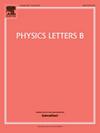轴子对γ射线谱不规则性的影响。II: EBL吸收的意义
IF 4.5
2区 物理与天体物理
Q1 ASTRONOMY & ASTROPHYSICS
引用次数: 0
摘要
河外背景光(EBL)在高能粒子在宇宙中的传播中起着至关重要的作用。在这项工作中,我们探讨了EBL吸收效应对高能伽玛射线光谱不规则性中光子到类轴子粒子(ALP)转换的影响。为此,我们选择了4颗BL蓝星进行分析:Markarian 501、1ES 0229+200、PKS 0301-243和PKS 0447-439。它们的红移范围大约在0.03到0.34之间。本文首先利用Finke-10、Franceschini-17和Saldana-Lopez-21三种常用的EBL光谱模型讨论了EBL吸收对γ射线能谱分布(SEDs)的影响。然后,我们考虑了天体物理磁场中的光子- alp转换。在ALP参数{ma,gaγ}平面上给出了这些EBL模型在ALP假设下的最佳拟合卡方分布,呈现出相似的分布。为了比较,我们定义了一个新的δ卡方χd2来量化卡方值的差异。还给出了χd2的分布和对应于最大δ卡方χd,max2的伽马射线SEDs的分布,以供比较。我们的结果表明,这些不同的EBL光谱模型的影响在低红移伽玛射线轴子镜中不占主导地位。在这些情况下,选择最新的EBL型号Saldana-Lopez-21就足够了。然而,随着源红移的增加,这种影响变得更加显著。本文章由计算机程序翻译,如有差异,请以英文原文为准。
Axion effects on gamma-ray spectral irregularities. II: Implications of EBL absorption
The extragalactic background light (EBL) plays a crucial role in the propagation of high-energy particles throughout the Universe. In this work, we explore the impact of the EBL absorption effect on photon to axionlike particle (ALP) conversions from the very-high-energy gamma-ray spectral irregularities. For our purpose, we select four BL Lac blazars: Markarian 501, 1ES 0229+200, PKS 0301-243, and PKS 0447-439 for analysis. Their redshifts range from approximately 0.03 to 0.34. We first discuss the EBL absorption effect on the gamma-ray spectral energy distributions (SEDs) using three common EBL spectral models: Finke-10, Franceschini-17, and Saldana-Lopez-21. Then we consider the photon-ALP conversions in astrophysical magnetic fields. The best-fit chi-square distributions of these EBL models under the ALP assumption in the ALP parameter plane are provided, showing similar distributions. For comparison, we define a new delta chi-square, , to quantify the difference in chi-square values. The distributions of and the gamma-ray SEDs corresponding to the maximum delta chi-square, , are also presented for comparison. Our results indicate that the influence of these different EBL spectral models is non-dominant at the low-redshift gamma-ray axionscope. In these cases, choosing the latest EBL model, Saldana-Lopez-21, is sufficient. However, as the redshift of the sources increases, this influence becomes more significant.
求助全文
通过发布文献求助,成功后即可免费获取论文全文。
去求助
来源期刊

Physics Letters B
物理-物理:综合
CiteScore
9.10
自引率
6.80%
发文量
647
审稿时长
3 months
期刊介绍:
Physics Letters B ensures the rapid publication of important new results in particle physics, nuclear physics and cosmology. Specialized editors are responsible for contributions in experimental nuclear physics, theoretical nuclear physics, experimental high-energy physics, theoretical high-energy physics, and astrophysics.
 求助内容:
求助内容: 应助结果提醒方式:
应助结果提醒方式:


